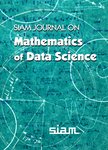版权所有:内蒙古大学图书馆 技术提供:维普资讯• 智图
内蒙古自治区呼和浩特市赛罕区大学西街235号 邮编: 010021

作者机构:Delft Univ Technol Delft Ctr Syst & Control NL-2628 CD Delft Netherlands Can Tho Univ Sch Educ Dept Math Can Tho Vietnam Univ Gottingen Inst Numer & Angew Math D-37083 Gottingen Germany Flexible Opt BV NL-2288 GG Rijswijk Netherlands
出 版 物:《SIAM JOURNAL ON MATHEMATICS OF DATA SCIENCE》
年 卷 期:2020年第2卷第1期
页 面:246-263页
核心收录:
基 金:European Research Council under the European Union's Seventh Framework Programme (FP7/2007-2013)/ERC grant German Israeli Foundation [G-1253-304.6] Deutsche Forschungsgemeinschaft Collaborative Research Center [SFB755]
主 题:phase retrieval sparsity constraint nonconvex optimization prox-regularity projection algorithm linear convergence
摘 要:In this paper, we propose and investigate the phase retrieval problem with the a priori constraint that the phase is sparse (SPR), which encompasses a number of practical applications, for instance, in characterizing phase-only objects such as microlenses, in phase-contrast microscopy, in optical path difference microscopy, and in Fourier ptychography, where the phase object occupies a small portion of the whole field. The considered problem is strictly more general than the sparse signal recovery problem, which assumes the sparsity of the signal because the sparsity of the signal trivially implies the sparsity of the phase, but the converse is not true. As a result, existing solution algorithms in the literature of sparse signal recovery cannot be applied to SPR and there is an appeal for developing new solution methods for it. In this paper, we propose a new regularization scheme which efficiently captures the sparsity constraint of SPR. The idea behind the proposed approach is to perform a metric projection of the current estimated signal onto the set of all the signals whose phase satisfies the sparsity constraint. The main challenge here is that the latter set is not convex and its associated projector in general does not admit a closed form. One novelty of our analysis is to establish an explicit form of that projector when restricted to those points which are relevant to the solutions of SPR. Note that this result is fundamentally different from the widely known calculation form for projections onto intensity constraint sets. Based on this new result, we propose an efficient solution method, named the sparsity regularization on phase (SROP) algorithm, for the SPR problem in the challenging setting where only one point-spread-function image is given, and we analyze its convergence. The algorithm is the combination of the Gerchberg-Saxton (GS) algorithm with the projection step described above. In view of the GS algorithm being equivalent to the alternating pro